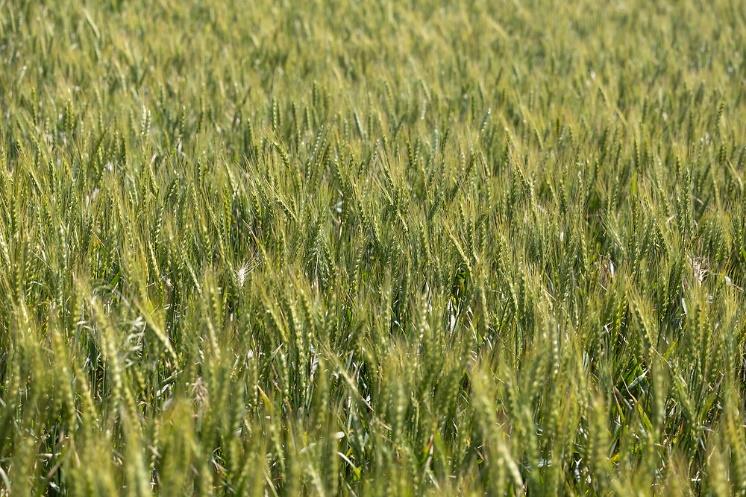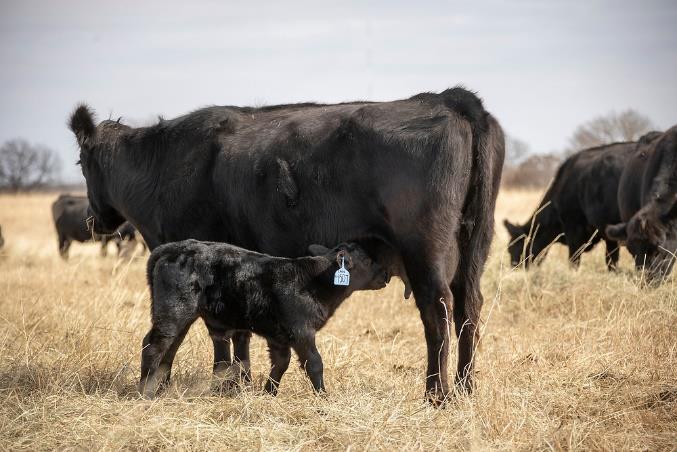Ag Insights February 2025
Saturday, February 1, 2025
Spring Management in Wheat
Josh Bushong, Area Extension Agronomist 
Planting date has once again proven to have played a critical role in growing wheat pasture this year. While some of the wheat that was late to emerge has remained small, it has produced a viable root system and will continue to develop new tillers this spring. When assessing wheat fields for grain yield potential, it is best to start by evaluating the stand.
Since many producers have adequate soil moisture and viable stands, there will be a good potential for wheat to respond favorably to additional inputs. If wheat stands are thin, economic thresholds for pests should be reduced to provide more protection. Until spring greenup, it’s always difficult to determine how much to topdress but late winter nitrogen topdressed can be beneficial to tiller production and grain yield.
Timely herbicide applications are key to early spring weed management. Especially if wheat was too small to make any fall herbicide applications. The sooner the better is what past OSU field research has shown. Most wheat herbicides need to be applied when temperatures start to get at least into the fifties. Ideally for good weed efficacy and crop safety, there should be a few days prior and following the herbicide application with good growing conditions.
When making herbicide applications this spring make sure to check labels to know if any adjuvants sure be added. Surfactant selection can also be dictated by wheat growth stage. Nonionic surfactants (NIS) typically have less issues with crop injury, but methylated seed oils (MSO) and crop oil concentrates (COC) will provide better weed control. Certain herbicides such as Beyond (for use only in Clearfield varieties) will also need a nitrogen source in addition to a surfactant.
Topdressing nitrogen tank-mixed with an herbicide or insecticide can be an economical option. Since the sprayer will be using a broadcast nozzle, such as a flat fan, Urea Ammonium Nitrate (UAN) rates should be limited to 10 to 20 gallons per acre depending on conditions. Applications should be avoided when air temperatures rise above 70° and relative humidity is low. Applications should be made prior to jointing stage, which will limit yield loss by allowing more recovery time if crop injury occurs.
Disease management has shown to be economical most years. If applied timely, most
commercially available fungicides have had good yield protection in OSU field trials.
If only one application is budgeted, it is best to
apply later to protect the flag leaf once it emerges. Long-term data typically average
about 10 to 20 percent more grain yield compared to no fungicide.
From 2014 to 2021, the OSU variety trial near Lahoma has evaluated more than 50 wheat varieties with and without a fungicide applied around the boot to flagleaf growth stage. Some varieties had good rust resistance and had little to no benefit to a fungicide application, while others had yield reductions of 20 to 40%. Including all varieties, there has been a 20% average increase in grain yield over that time frame. 6 of the 8 years the fungicide application protected grain yield.
The disease must be present to protect yield with a fungicide application. Knowing whether or not your wheat variety has good tolerance or resistance to leaf diseases is another factor to be considered. At the current wheat prices, if the wheat has a yield potential of at least 30 bushels per acre, then more than likely it will be economical to apply a fungicide if foliar diseases develop on the wheat.
Timely field scouting is the only way to determine if a pest is present and if an application of an herbicide, insecticide, or fungicide is warranted. The only way for one of these pesticides to protect yield and have a positive return on investment would be knowing what pests are present and knowing how much yield potential can be saved if applied correctly.
Cattle Nutrition Now More Important Than Ever
Dana Zook, NW OK Area Livestock Specialist
I’ve lived in Oklahoma now for almost 15 years. Some would say that makes me an “Oklahoman”, others maybe not. It might not help that I still drive around with a “Big Red N” on my bumper and relish being called a Cornhusker, a Yankee, or being told I grew up in the “Great White North”. As you might expect, some phrases and terminology are a little different in Oklahoma. For instance, since moving to OK, I have always found it fascinating that local ag producers refer to the calendar year beyond January as “Spring”. Just as soon as Christmas is over it’s time for “Spring Calving” and “Spring Green-up”. What occurs in January and February is quite the opposite. In the context of cattle nutrition, we are in the toughest time of year for cows. Because of this, let’s do a little review on nutritional needs for cows this time of year.
Don’t overestimate the quality of forage
At this point in the year, standing forage is pretty low quality.
According the feed library on the OSU Cowculator, standing native and bermuda range
about 4-5% protein and 47-50% TDN. As a reminder, gestating cows need a baseline diet
of 8% protein and 54% TDN. Lactating cows need quite a bit more, increasing the need
to 10% protein and 58% TDN on a total diet basis. If this is the forage base producers
are working with, please know there is a huge nutritional gap here between what cows
have and what they need to maintain nutrition. Here is a realistic example of nutrition
and supplementation of a cow in February: A lactating cow on standing native grass
this month needs 8-10 lbs. of 20’s every day to maintain condition. This is A LOT!
Of course, higher quality hay sources and higher protein supplements can help defray
these amounts.
Don’t forget the weather impacts
According to the Mesonet Cattle Comfort Advisor, a cows energy requirement increases 1% for each degree the cattle comfort index is below 32. This energy need would double to 2% if the animal is wet to the skin. So how does this equate to actual feed? A producer feeding 20% cubes to gestating cows would need to provide an additional 3.5 – 4 pounds of cubes daily to maintain body condition. The lactating cow’s energy requirement is much higher and therefore they will need an additional 4.5-5 pounds 20% cubes daily. Remember, increasing feeding allotments like this could cause some digestive upset if fed all at once. For this reason, it may be beneficial to slowly increase feeding a few days before cold weather strikes and then continue a few days after to recover some energy loss. Also, cows that are fed just twice or three times per week may benefit from feeding more often to distribute higher feeding levels. Again, don’t forget high quality hay sources as an option to bridge the energy gap in these situations.
I hope this gives producers something to think about. No cows go by the book so take my numbers with a “grain of salt” as they say. As we turn the calendar to February, I can’t stress enough the value a forage analysis or even getting a consultation on the nutrition. If any producers want to double check their supplementation amounts, give your extension office a call. We would be happy to work through the values with you. We are all ready for spring but it’s important to keep our eye on the task of keeping our cows in good condition at a time when there is a big drain on her system. Stay warm friends!
ARC/PLC Enrollment Periods for Year 2025
Alberto Amador, Area Ag Economics Specialist
2025 is underway, marking a global year of change and instability across multiple industries. However, change often brings opportunity. Agriculture is no exception, as farmers and producers will face risks and challenges, including fluctuations in production outcomes and price variability. In this context, federal safety-net programs play a crucial role in helping manage risk and protect against market volatility in the agriculture commodities sector.
On January 13, the U.S Department of Agriculture (USDA) announced the 2025 enrollment
periods for two of its most popular programs, the Agriculture Risk Coverage (ARC)
and Price Loss Coverage (PLC). Both programs provide financial protection against
significant drops in crop revenues or prices.
To assist with program selection table 1 below shows the Effective Reference Prices
(ERPs) for the 2025 Crop year. Additionally, you can download the county benchmarks
for the 2025 ARC-Co program.
Fortunately, there are multiple resources and tools available to help facilitate program selection. These tools allow you to explore different scenarios and determine which program may be most applicable in various situations. Two accessible and user-friendly tools are provided by Kansas State University and the University of Illinois. Although these tools are valuable for broadening your perspective, use them as a helpful starting point rather than a definitive guide.
The enrollment period for the ARC and PLC programs begins on January 21, with a deadline of April 15. Whether producers decide to keep their current election or make changes for 2025, they must enroll annually through a signed contract.
To recap the covered commodities for these programs, include barely, canola, large and small chickpeas, corn, crambe, grain sorghum, lentils, mustard seed, oats, peanuts, dry peas, rapeseed, long and medium grain rice, safflower seed, seed cotton, sesame, soybeans, sunflower seed, and wheat.
I strongly recommend enrolling well before the deadline. I encourage the producers to reach out to their local Farm Service Agency (FSA). Additionally, please don’t hesitate to contact OSU Extension offices — we would be delighted to support you.
| Covered Commodity | Units | 2025 ERP |
|---|---|---|
| Wheat | Bushel | $5.56 |
| Barley | Bushel | $4.95 |
| Oats | Bushel | $2.76 |
| Peanuts | Pound | $0.2675 |
| Corn | Bushel | $4.26 |
| Grain Sorghum | Bushel | $4.51 |
| Soybeans | Bushel | $9.66 |
| Dry Peas | Pound | $0.1163 |
| Lentils | Pound | $0.2297 |
| Canola | Pound | $0.2054 |
| Large Chickpeas | Pound | $0.2477 |
| Small Chickpeas | Pound | $0.2190 |
| Sunflower Seed | Pound | $0.2015 |
| Flaxseed | Bushel | $11.53 |
| Mustard Seed | Pound | $0.2317 |
| Rapeseed | Pound | $0.2015 |
| Safflower | Pound | $0.2275 |
| Crambe | Pound | $0.2100 |
| Sesame Seed | Pound | $0.2317 |
| Seed Cotton | Pound | $0.2670 |
| Rice (long grain) | Pound | $0.1400 |
| Rice (med/short grain) | Pound | $0.1400 |
| Rice (temperate japonica) | Pound | $0.1990 |
Extension Experience – Insights into Oklahoma Agriculture
The Extension Experience podcast is brought to you by Josh Bushong and Dana Zook. Biweekly episodes provide perspectives on Agriculture topics and offer insight from our experience working with OSU Extension Educators and producers across Oklahoma.
The Extension Experience podcast is available on Spotify and Apple Podcast platforms.
You can also access the episodes on our blog.
You can also find and share our podcast from our Facebook page!
We hope you consider listening to the Extension Experience.
Recent Topics:
- Goat Pneumonia with Dr. Meredyth Jones
- Livestock Markets, Demand, and Holiday Shenanigans
